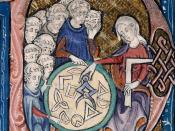The role of women has changed dramatically throughout the centuries. The early years for women were always harsh and demanding, but as time went on and feminism spread, the role of women and family became more dominant.
The male Christian clergy portrayed women in the Middle Ages having two options: subjugated housewife or confined nun. Fortunately, most medieval women avoided both fates. The vast majority of them, in fact, worked in a range of trades, though they were concentrated in the food and clothing industries. Nuns avoided the problems associated with pregnancy, and could attain some power. Aristocratic women could manage large households. Most historians have probably misunderstood the lives of children in the Middle Ages. Children had a 30-50% chance of dying before they turned five, so some historians have suggested that parents would not risk making a big emotional investment in young children; some children were even killed deliberately.
Children worked as soon as they were able, and are depicted in medieval art as "little adults," so some historians have wondered whether people in the Middle Ages had an understanding of childhood as a distinct phase of life, with its own needs. But medieval medical and clerical authorities did, in fact, write about childhood as a special stage in life, and there is also evidence that parents and society at large cherished their babies and children. One of the first women to step up to men was Joan of Arc. She convinced the kind to give her command of his army in order to reverse French fortunes. Although she led the French to great victory, the men executed her as a heretic on May 30, 1431.
Marriage occurred at a later age (mid- to late-twenties for men, early to mid-twenties for women) in the 16th-18th centuries than it...


